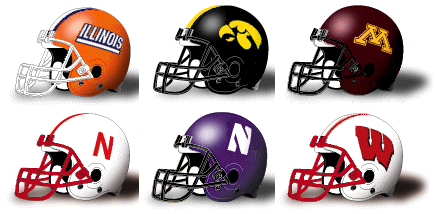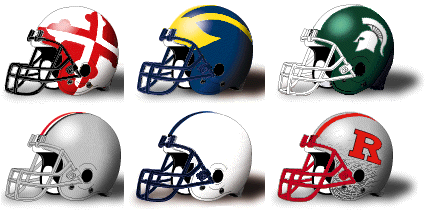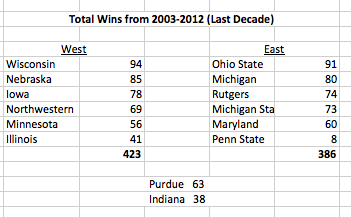New BigTen Divisions Set for 2014 Season: East and West
A comprehensive breakdown of the competitive balance of the new setup
BRETT CIANCIA
April 14th, 2013
April 14th, 2013
Conference Realignment rages on with the coming additions to the Big Ten in 2014: Maryland and Rutgers. Just as the College Football world was getting used to the Big Ten Leaders and Legends divisions, new plans for divisions will be instituted for the 2014 season. The league’s athletic directors are planning on restructuring the divisions, this time with a geographic focus. In 2011 with the addition of 12th member Nebraska, Commissioner Jim Delany’s choice to name the original divisions “Leaders” and “Legends” received a very low approval rate across the conference. Now the shift to an East/West breakdown is also receiving mixed reactions; this time it’s not about the names, but about a perceived talent imbalance. Here are the new division alignments that will go into effect for the 2014 season:
The immediate reaction is that the East is loaded while the West is lacking, but in reality the ‘imbalance’ is not as bad as perceived. Yes, the East has 3 of the 4 “Power Programs” that are assumed to be Ohio State, Michigan, Nebraska, and Penn State. But is it really fair to call Penn State an elite program anymore? With the crippling sanctions upcoming and the loss of fan support in Happy Valley, Penn State is not the powerhouse it was in the ‘80s. Conversely, how can we not consider Wisconsin ‘elite,’ having represented the conference in the Rose Bowl for the past 3 seasons? The resurgence of the Northwestern football program under coach Pat Fitzgerald further strengthens the West Division. Iowa and Michigan State have been comparable over the past decade, each with a few 10+ win seasons and a few down years. That leaves Illinois and Minnesota of the West and newcomers Maryland and Rutgers of the East. These West teams have struggled historically, while the new teams will have a more challenging schedule than in previous years (ACC and Big East). After further review, these divisions are more comparable than the vocal majority is claiming.
For some quantitative analysis on competitive balance, here are the win totals over three periods: 1951-present (Modern Era of College Football), 1993-present (addition of Penn State to Big Ten), and 2003-present (Past Decade)
For some quantitative analysis on competitive balance, here are the win totals over three periods: 1951-present (Modern Era of College Football), 1993-present (addition of Penn State to Big Ten), and 2003-present (Past Decade)
Total National Championships over same intervals:
1951-present: East 17, West 7
1993-present: West 3, East 2
2003-present: None (2002 Ohio State was last BigTen National Champion)
1951-present: East 17, West 7
1993-present: West 3, East 2
2003-present: None (2002 Ohio State was last BigTen National Champion)
Once the dust settles, I think Jim Delany excelled in both competitive balance, and integrity of rivalries – all the while keeping the geography a priority. Time and time again we see the perceived ‘dominant’ division crumble and the other soar. The creation of the Big12 had the 1990’s powers Nebraska, Colorado, and Kansas State all placed in the North Division while sleeping giants Oklahoma and Texas were South members. There were similar talent fluctuations in the SEC over its 20-year division history. College football is cyclical, but for the time being, Delany has assembled a very balanced 14 team conference.
With the frequent conference realignment nowadays, I wonder if we will ever see these divisions implemented, or if by then the BigTen is a 16+ member Super Conference. Only time will tell.
With the frequent conference realignment nowadays, I wonder if we will ever see these divisions implemented, or if by then the BigTen is a 16+ member Super Conference. Only time will tell.
RELATED ARTICLE: Conference Realignment 2013






